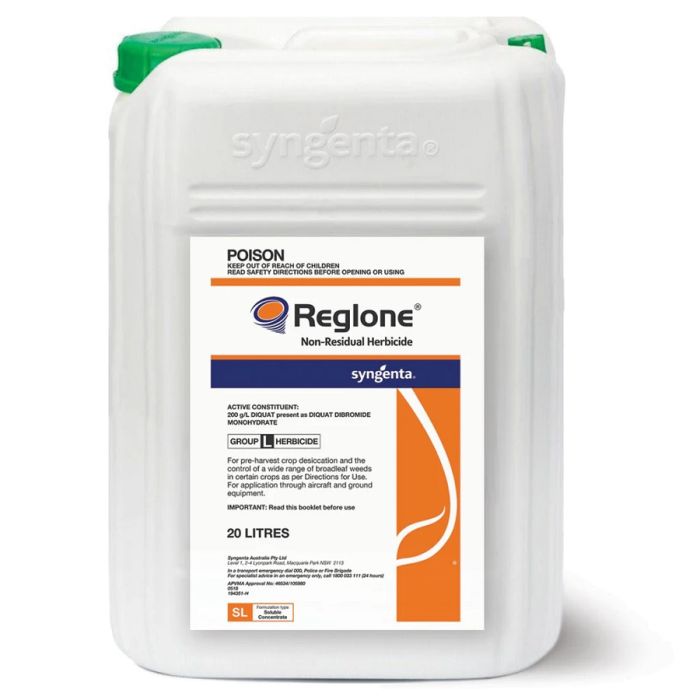Reglone Herbicide 20L
Estimate Delivery
Blacktown, NSW
Low On stockUnit 1, Building 2 / 13 Bessemer Street
Blacktown
NSW
2148
Kwinana, WA
Low On stock16 Thomas Rd
Kwinana Beach
WA
6167
Newcastle, NSW
Awaiting Stock11 Nevin Close
Gateshead
NSW
2290
Tullamarine, VIC
Awaiting Stock19 Silicon Place
Tullamarine
VIC
3043
Globe Pest Solutions Brisbane
Awaiting Stock579 Boundary Road
Archerfield
QLD
4108
Welland, SA
Awaiting Stock134-140 Frederick St
Welland
SA
5007
Globe Pest Solutions Padstow
Awaiting Stock39 Gow Street
Padstow
NSW
2211
Stapylton, QLD
Awaiting Stock82 Christensen Road
Stapylton
QLD
4207
Reglone Herbicide is a non selective contact herbicide containing 200g/L diquat present as diquat dibromide monohydrate. It is fast-acting non-volatile, aqueous solution, providing unrivalled speed of kill in the destruction of green plant tissue. Reglone interferes with the process of photosynthesis, causing rapid desiccation of foliage for pre-harvest weed control or crop desiccation.
Mode of action
Light and green leaf tissue are essential components to the activity of Reglone. The herbicide acts as a catalyst in the chloroplasts of plant cells, interfering with the process of photosynthesis at Photosystem I. The active ingredient diquat, diverts electron flow causing the production of peroxides and free electrons. These superoxides attack proteins and cell membranes, ultimately leading to desiccation of plant tissue.
Following the application of Reglone, penetration through the leaf surface occurs almost immediately and the physiological action of diquat takes place within a matter of minutes.
Due to the requirement of light for photosynthesis, Reglone is inactive in darkness. Despite this, the herbicide may continue limited diffusion into neighbouring cells in the absence of light. For this reason, Reglone often provides a more effective kill when applied at dusk or on cloudy, overcast days, as the cell desiccation reaction is delayed until the compound has moved more evenly throughout the leaf.
Reglone binds quickly and strongly to soil and organic material and is no longer biologically active once absorbed. The herbicide therefore poses a negligible risk to leaching and is readily degraded by soil microbes to natural products including water, carbon dioxide and ammonia.
Uses
In Western Australia, Reglone is registered for pre-harvest desiccation in Canola, Lupins and certain pulse crops and for pre-harvest general weed control in Winter Cereals.
It is also an aquatically approved herbicide, registered for the control of Duck Weed, Azolla, Water Hyacinth, Salvinia and Water Lettuce.
Always refer to the product label for full directions of use.
Application
As translocation of the active ingredient is extremely limited, spray coverage is critical. Nozzle selection, boom height and water volume should aim to maximise coverage whilst minimising potential for spray drift. High humidity, light dew or light rain (below the point of run-off) may help to spread the product more evenly across the leaf surface, though should not be replied upon alone.
To optimise product efficacy complete coverage is essential, with full penetration into the target foliage necessary. A boomsprayer fitted with flat fan nozzles is preferred to ensure even coverage and minimise drift. The boom should be set at sufficient height above the crop to provide a complete double overlap of the flat spray pattern. Best results will be obtained when application is made in dull weather or at the end of the day. Avoid spraying in high winds or under temperature inversion conditions. Avoid spraying if the Delta value is >10°C.
| Brand | Syngenta |
|---|---|
| Active Ingredients | 200g/L Diquat |
| Product Form | Liquid |
| Product Alias | reglone-herbicide-20l |
| Selectivity | Non-Selective |
| Mobility Type | Contact |
| Formulation Type | Soluble Concentrate (SL) |
| Activity | Post-Emergent |
| MOA Group | Group 22 Herbicide |
| Weeds Controlled | Barley Grass, Brome Grass, Capeweed, Saffron Thistle |
| Application Rate | 50-100mL per 100m² |
| Australian Made | No |

